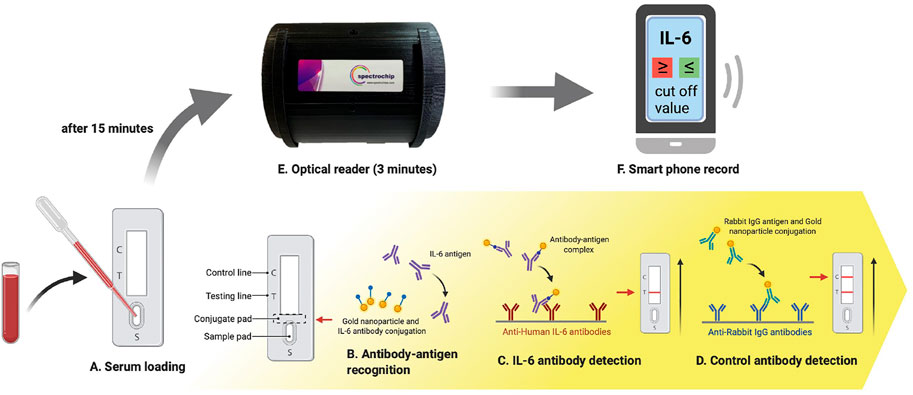
94% of researchers rate our articles as excellent or good
Learn more about the work of our research integrity team to safeguard the quality of each article we publish.
Find out more
CORRECTION article
Front. Bioeng. Biotechnol., 15 December 2021
Sec. Nanobiotechnology
Volume 9 - 2021 | https://doi.org/10.3389/fbioe.2021.802615
This article is part of the Research TopicDetection Nanodevices for Infectious DiseasesView all 7 articles
This article is a correction to:
A Paper-Based IL-6 Test Strip Coupled With a Spectrum-Based Optical Reader for Differentiating Influenza Severity in Children
A Corrigendum on
A Paper-Based IL-6 Test Strip Coupled With a Spectrum-Based Optical Reader for Differentiating Influenza Severity in Children
by Lin, S.-W., Shen, C.-F., Liu, C.-C., and Cheng, C.-M. (2021). Front. Bioeng. Biotechnol. 9:752681. doi:10.3389/fbioe.2021.752681
In the original article there was an error in the Funding statement. The correct number for “Ministry of Science and Technology, Taiwan” is “MOST 110-2628-E-007-003.” The correct Funding statement appears below. Additionally, there were mistakes present in the captions for Figures 1–4, these have been corrected and the correct captions appear below.

FIGURE 1. The IL-6 paper-based test strip and spectrum-based optical reader. (A) The IL-6 test strips loaded with pre-determined amounts of purified IL-6 protein. (B) Spectrum-based optical reader and mobile-phone which could connect to the reader (in collaboration with SpectroChip Inc., Taiwan; Taiwan FDA: MD (I)-008090 and U.S. FDA: 3017810861). (C) The reflectance spectra of the predetermined amounts of purified IL-6 protein in standard scale. (D) Linear regression for the α value of IL-6 protein at concentrations of 0, 0.1, 0.2, 0.4 pg/ml to determine the limit of detection (LOD) and limit of quantification (LOQ), Y-axis; α value, X-axis; IL-6 concentration based on test strip coupled with optical reader, *p < 0.05, ***p < 0.001.

FIGURE 2. (A) Comparison of paper-based test strip and ELISA for IL-6 assays using serum from patients, including influenza, enterovirus, Mycoplasma, dengue, n = 83. Y-axis; IL-6 concentration measured by test strip. X-axis; IL-6 concentration measured by ELISA. (B) Bland and Altman plot of log-transformed data. The differences between the IL-6 based on test strip and ELISA (log transformation) in relation to the mean of the two measurements (log transformation), n = 83. Green lines indicate the limits of agreement (±1.96 SD).

FIGURE 3. IL-6 levels in severe cases and mild cases of influenza in children based on test strip and ELISA. (A) IL-6 (test strip) concentration between different groups: severe influenza (n = 23), mild influenza (n = 26), health control (n = 10). (B) IL-6 (ELISA) concentration between different groups: severe influenza (n = 23), mild influenza (n = 26), health control (n = 10). There was a statistically significant difference between severe cases and healthy controls (p < 0.05). (C) Follow-up IL-6 test strip concentrations compared to number of days in the hospital for two patients. (D) ROC curve of IL-6 concentration (test strip), AUC = 0.69, p = 0.026. (E) ROC curve of IL-6 concentration (ELISA), AUC = 0.64, p = 0.092. (F) ROC curve of IL-6 concentration (test strip) combined with CRP, AUC = 0.911, p = 0.00. (G) ROC curve of IL-6 concentration (ELISA) combined with CRP, AUC = 0.654, p = 0.085.

FIGURE 4. The IL-6 test strip workflow coupled with a spectrum-based optical reader. This new spectrum analyzer platform system requires only 0.1 ml of blood serum to be added to the test strip, and provides results in 15 min. The test strip is placed in a spectrometer for quantitative spectral analysis. This scan takes approximately 3 min to complete. Automatic scanning of the rapid test strip is activated with an APP. Full-spectrum antibody reflex optical signals are acquired from the spectral optical module to analyze IL-6 full-spectrum antibody distribution and concentration with standard quantification.
The authors apologize for these errors and state that they do not change the scientific conclusions of the article in any way. The original article has been updated.
This study is funded by research grants from the Ministry of Science and Technology, Taiwan (MOST 110-2628-E-007-003 and MOST 110-2923-B-006-001-MY4), and Institute of Clinical Medicine, National Cheng Kung University Hospital, Taiwan (NCKU11002017).
All claims expressed in this article are solely those of the authors and do not necessarily represent those of their affiliated organizations, or those of the publisher, the editors, and the reviewers. Any product that may be evaluated in this article or claim that may be made by its manufacturer is not guaranteed or endorsed by the publisher.
Keywords: influenza infection, interleukin-6, spectrum-based optical reader, point-of-care testing, paper-based test strip, children
Citation: Lin S-W, Shen C-F, Liu C-C and Cheng C-M (2021) Corrigendum: A Paper-Based IL-6 Test Strip Coupled With a Spectrum-Based Optical Reader for Differentiating Influenza Severity in Children. Front. Bioeng. Biotechnol. 9:802615. doi: 10.3389/fbioe.2021.802615
Received: 26 October 2021; Accepted: 15 November 2021;
Published: 15 December 2021.
Approved by:
Frontiers Editorial Office, Frontiers Media SA, SwitzerlandCopyright © 2021 Lin, Shen, Liu and Cheng. This is an open-access article distributed under the terms of the Creative Commons Attribution License (CC BY). The use, distribution or reproduction in other forums is permitted, provided the original author(s) and the copyright owner(s) are credited and that the original publication in this journal is cited, in accordance with accepted academic practice. No use, distribution or reproduction is permitted which does not comply with these terms.
*Correspondence: Chao-Min Cheng, Y2hhb21pbkBteC5udGh1LmVkdS50dw==; Ching-Chuan Liu, bGl1Y2NAbWFpbC5uY2t1LmVkdS50dw==
†These authors have contributed equally to this work
Disclaimer: All claims expressed in this article are solely those of the authors and do not necessarily represent those of their affiliated organizations, or those of the publisher, the editors and the reviewers. Any product that may be evaluated in this article or claim that may be made by its manufacturer is not guaranteed or endorsed by the publisher.
Research integrity at Frontiers

Learn more about the work of our research integrity team to safeguard the quality of each article we publish.